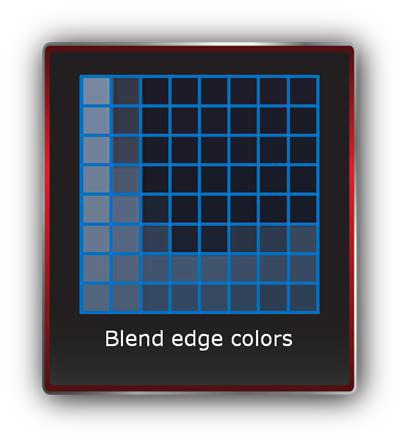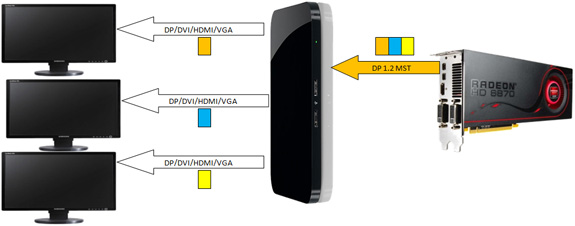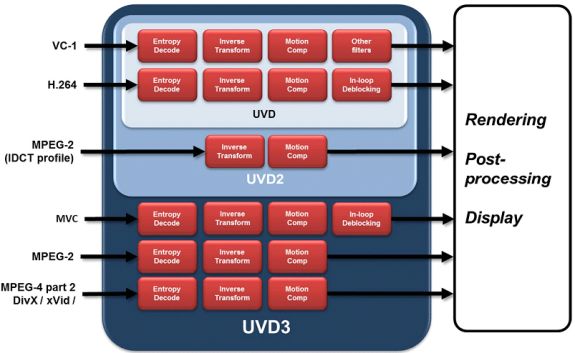AMD's Radeon HD 6970 & Radeon HD 6950: Paving The Future For AMD
by Ryan Smith on December 15, 2010 12:01 AM ESTRefresher: The 6800 Series’ New Features
Back in October AMD launched the first 6000 series cards, the Barts-based Radeon HD 6800 series. At their core they are a refreshed version of the Cypress GPU that we saw on the 5800 series, but AMD used the opportunity to make some enhancements over the standard Cypress. All of these enhancements apply throughout the 6000 series, so this includes the 6900 series. As such for those of you who didn’t pay much attention to the 6800 series, we’re going to quickly recap what’s new in order to lay the groundwork for further comparisons of the 6900 series to the 5800 series.
We’ll start with the core architecture. Compared to Cypress, Barts is nearly identical save 1 difference: the tessellator. For Barts AMD implemented what they call their 7th generation tessellator, which focused on delivering improved tessellation performance at lower tessellation factors that AMD felt were more important. Cayman takes this one step further and implements AMD’s 8th generation tessellator, which as the naming conventions implies is the 7th generation tessellator with even further enhancements (particularly those necessary for load balancing).
The second change we saw with Barts and the 6800 series was AMD’s refined texture filtering engine. AMD’s texture filtering engine from the 5800 set new standards by offering angle independent filtering, but it had an annoying quirk with highly regular/noisy textures where it didn’t do a good enough job blending together various mipmaps, resulting in visible transitions between them. For the 6800 series AMD fixed this, and it can now properly blend together noisy textures. At the same time in a controversial move AMD tweaked its default filtering optimizations for the 5800 series and entire 6000 series, leading to these cards producing imagines subtly different (and depending on who you ask, subtly worse) than they were on the 5800 series prior to the Catalyst 10.10 drivers.

| Radeon HD 5870 | Radeon HD 6870 | GeForce GTX 480 |
The third change we saw was the introduction of a new anti-aliasing mode, initially launched on the 6800 series and backported to the 5800 series shortly thereafter. Morphological Anti-Aliasing (MLAA) is a post-processing filter that works on any (and all) images, looking for high contrast edges (jaggies) and blending them to reduce the contrast. Implemented as a compute shader, it works with all games. As it’s a post-processing filter the results can vary – the filter has no knowledge of depth, polygons, or other attributes of the rendered world beyond the final image – so it’s prone to blending everything that looks like aliasing. On the plus side it’s cheap to use as it was originally designed for consoles with their limited resources, so by not consuming large amounts of memory & memory bandwidth like SSAA/MSAA it usually has a low performance hit.


Last but not least, AMD made a number of changes to their display hardware. The Universal Video Decoder (UVD) was upgraded to version 3, bringing full decode support for MPEG-2, MPEG-4 ASP, and H.264 MVC (packed frame video for 3D movies). For the 6900 series this is not of great importance as MPEG-2 and MPEG-4 ASP are low complexity codecs, but it does play an important role for AMD’s future APU products and low-end GPUs, where offloading these low complexity codecs is still going to be a big relief for the slower CPUs they’re paired with. And on that note the first public version of the DivX codec with support for UVD3 will be shipping today, letting 6800/6900 series owners finally take advantage of this functionality.
The second of the major display changes was the addition of support for the DisplayPort 1.2 standard. DP1.2 doubles DisplayPort’s bandwidth to 21.6Gbps, finally giving DisplayPort a significant bandwidth lead over dual-link DVI. With double the bandwidth it’s now possible to drive multiple monitors off of a single root DisplayPort, a technology called Multi Stream Transport (MST). AMD is heavily banking on this technology, as the additional bandwidth coupled with the fact that DisplayPort doesn’t require a clock source for each monitor/stream means AMD can drive up to 6 monitors off of a single card using only a pair of mini-DP ports. AMD is so cutting edge here that like the 6800 series the 6900 series is technically only DP1.2 ready – there won’t be any other devices available for compliance testing until 2011.

Finally, the 6800 series also introduced support for HDMI 1.4a and support for color correction in linear space. HDMI 1.4a support is fairly straightforward: the 6000 series can drive 3D televisions in either the 1080p24 or 720p60 3D modes. Meanwhile support for color correction in linear space allows AMD to offer accurate color correction for wide gamut monitors; previously there was a loss of accuracy as color correction had to be applied in the gamma color space, which is only meant for use for display purposes. This is particularly important for integrating wide gamut monitors in to traditional gamut workflows, as sRGB is misinterpreted on a wide gamut monitor without color correction.
While all of these features were introduced on the 6800 series, they’re fundamental parts of the entire 6000 series, meaning they’re part of the 6900 series too. This provides us with a baseline set of improvements over AMD’s 5800 series, on top of the additional improvements Cayman and AMD’s VLIW4 architecture brings.











168 Comments
View All Comments
Roland00Address - Wednesday, December 15, 2010 - link
1) The architecture article is something that can be written before hand, or written during benching (if the bench is on a loop). It has very little "cramming" to get out right after a NDA ends. Anand knows this info for a couple of weeks but can't discuss it due to NDAs. Furthermore the reason anandtech is one of the best review sites on the net is the fact they do go into the architecture details. The architecture as well as the performance benchmarks is the reason I come to anandtech instead of other review sites as my first choice.2) The spelling and grammar errors is a common thing at anandtech, this is nothing new. That said I can't complain for my spelling and grammar is far worse than Ryan's.
If you don't like the style of the review go somewhere else.
Ryan Smith - Wednesday, December 15, 2010 - link
1) That's only half true. AMD told us the basics about the 6900 series back in October, but I never had full access to the product information (and more importantly the developers) until 1 week ago. So this entire article was brought up from scratch in 1 week.It's rare for us to get too much access much earlier than that; the closest thing was the Fermi launch where NVIDIA was willing to talk about the architecture months in advance. Otherwise that's usually a closely held secret in order to keep the competition from having concrete details too soon.
Dracusis - Wednesday, December 15, 2010 - link
Neither the AMD 6xxx series or Nvidia's 5xx series have been added. Would like to see how my 4870x2 stack up against this latest generation and weather or not it's worth upgrading.Makaveli - Wednesday, December 15, 2010 - link
The Canadian pricing on these cards are hilarious.Ncix is taking preorder for the 6970 at $474.
While they sell the 570 for $379.
Can someone explain to me why I would pay $100 more for the radeon when the 570 gives equal performance?
Are these retailers that retarded?
stangflyer - Thursday, December 16, 2010 - link
They will price the 6950/6970 high for a few days to get the boys that bleed red and have to have the new cards right away to pay top dollar for the card.After a week they will probably be about the same price.
Ryan Smith - Thursday, December 16, 2010 - link
Bench will be up to date by the start of next week.Paladin1211 - Thursday, December 16, 2010 - link
Whats wrong with you rarson? Do you even know whats the difference between "Graphics card review", "Performance review", "Performance Preview"? I dont know how good your grammar and spelling are, but they dont matter as long as you cant understand the basic meaning of the words.Most of the sites will tell you about WHAT, but here at AnandTech, you'll truly find out WHY and HOW. Well, of course, you can always go elsewhere try to read some numbers instead of words.
Keep up the good works, Ryan.
Belard - Thursday, December 16, 2010 - link
The 3870 and 3850 were the TOP end for ATI, as was the 4800 and the 5800. Their relationship of model numbers do not have anything to do with the status of Nvidia.When the 3870 was brand new, what was the HIGHEST end card ATI had back then? Oh yeah, the 3870!
4800 is over the 3870, easily.
4600 replaced the 3800
The 5800s replaces the 4800s... easily.
the 5700s kind of replaced the 4800s.
The 6800s replaces the 5700 & 5800s, the 6900s replace the 5800s, but not so much on performance.
I paid $90 for my 4670 and a much better value than the $220 3870 since both cards perform almost the same.
AmdInside - Thursday, December 16, 2010 - link
I can't think of a single website that has better hardware reviews, at least for computer technology than Anandtech. Ryan, keep up the great work.George.Zhang - Thursday, December 16, 2010 - link
BTW, HD6950 looks great and affordable for me.